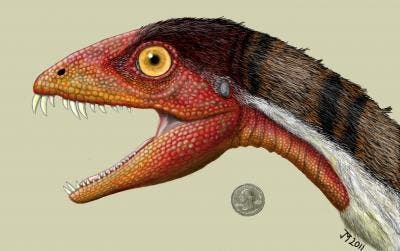
Artist impression ofthe Daemonosaurus chauliodus shows its size relative to an American quarter. (c) Jeffrey Martz
A team of paleontologists from the Smithsonian Institute have uncovered the fossils of a brand new dinosaur species in Ghost Ranch, New Mexico which posses a particular importance by filling the family tree gap between early predatory species such as Herrerasaurus and later theropod dinosaurs.
Researchers named the species Daemonosaurus chauliodus, based on the Greek words “daimon” meaning evil spirit, since it was found in Ghost Ranch (superstitious excavators, uh?) and “sauros” meaning lizard or reptile. The species name chauliodus is derived from the Greek word for “buck-toothed” and refers to the species’ big slanted front teeth as seen in the skull and neck of the Daemonosaurus, which were actually the only fossils found.
Because of the scarce number of fossils, it’s size is difficult to asses it’s length. What researchers know, though, is that the dinosaur’s skull is narrow and relatively deep, measuring 5.5 inches long from the tip of its snout to the back of the skull and has proportionately large eye socket.
Scientists have dated the Daemonosaurus approximately 205 million years ago, in the Triassic Period, just before the beginning of the Jurassic Period, which posses a remarkable significance since all basal (primitive) dinosaurs had vanished millions of years earlier.
“Various features of the skull and neck in Daemonosaurus indicate that it was intermediate between the earliest known predatory dinosaurs from South America and more advanced theropod dinosaurs,” said Hans Sues, curator of vertebrate paleontology at the Smithsonian’s National Museum of Natural History and lead author of the team’s findings. “One such feature is the presence of cavities on some of the neck vertebrae related to the structure of the respiratory system.”
This new discovery shows that there is still much to be learned about the early evolution of dinosaurs. “The continued exploration of even well-studied regions like the American Southwest will still yield remarkable new fossil finds,” Sues said.









